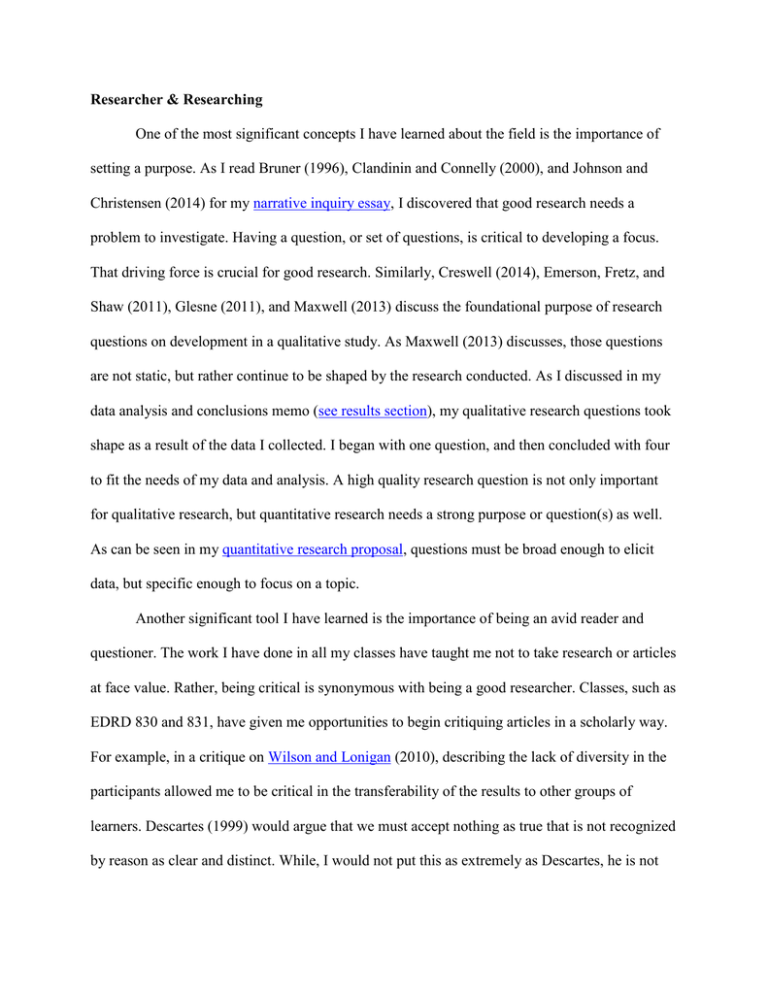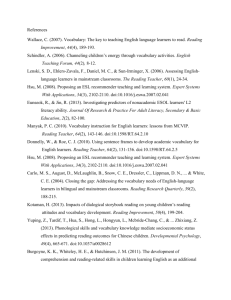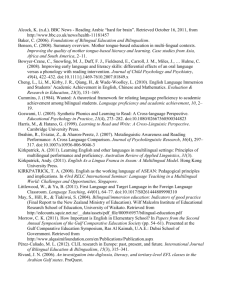Knowledge Essay
advertisement

Researcher & Researching One of the most significant concepts I have learned about the field is the importance of setting a purpose. As I read Bruner (1996), Clandinin and Connelly (2000), and Johnson and Christensen (2014) for my narrative inquiry essay, I discovered that good research needs a problem to investigate. Having a question, or set of questions, is critical to developing a focus. That driving force is crucial for good research. Similarly, Creswell (2014), Emerson, Fretz, and Shaw (2011), Glesne (2011), and Maxwell (2013) discuss the foundational purpose of research questions on development in a qualitative study. As Maxwell (2013) discusses, those questions are not static, but rather continue to be shaped by the research conducted. As I discussed in my data analysis and conclusions memo (see results section), my qualitative research questions took shape as a result of the data I collected. I began with one question, and then concluded with four to fit the needs of my data and analysis. A high quality research question is not only important for qualitative research, but quantitative research needs a strong purpose or question(s) as well. As can be seen in my quantitative research proposal, questions must be broad enough to elicit data, but specific enough to focus on a topic. Another significant tool I have learned is the importance of being an avid reader and questioner. The work I have done in all my classes have taught me not to take research or articles at face value. Rather, being critical is synonymous with being a good researcher. Classes, such as EDRD 830 and 831, have given me opportunities to begin critiquing articles in a scholarly way. For example, in a critique on Wilson and Lonigan (2010), describing the lack of diversity in the participants allowed me to be critical in the transferability of the results to other groups of learners. Descartes (1999) would argue that we must accept nothing as true that is not recognized by reason as clear and distinct. While, I would not put this as extremely as Descartes, he is not far off when he says we need concrete evidence to create these paradigms. Having evidence to aid in understanding concepts is critical. I am learning the importance of having research to back up all of my ideas. For example, as I created my interview questions for my research study, I read several articles to help formulate appropriate questions to ask. Growing Knowledge in the Field of Literacy Moreover, literacy research shows that we need to meet the needs of students. Through my work on vocabulary development for ELLs, at risk students, and students of poverty, I found that researchers, such as Jackson and his colleagues (2014) and Gorman (2012), discuss the need to not expect all students to perform at the same level and that we must make helping these students of high priority. Similarly, researchers such as Ivey (1999, 2012) advocate that making the needs of learners in general is of high priority. Through exploration of culturally relevant pedagogy, I have found that many other researchers, such as Brooks (2006), Ladson-Billings (1995), and Worthy, Moorman, and Turner (1999) have also been studying the importance of understanding students’ perceptions, specifically adolescents, to engage them in more successful literacy practices. In addition, to meet the needs of our learners, scholars are now advocating for classroom strategies to include multimodal approaches to learning. Researchers such as Ware (2008), Turner, Hayes, and Way (2013), and Zenkov and Harmon (2009) have begun exploring how these multimedia approaches can better engage diverse learners. As I explored more in depth what culturally relevant pedagogy was, a quote stuck with me, “defining cultural relevance my not be as important as the process of engaging youth in activities” (Zenkov et al., 2013). This notion of worrying less about what concepts mean and more about how we engage youth in literacy practices is where we should be focusing our attention. One of the emerging themes I have found is the unfortunate gap between research and classroom practice. Bridging the gap between what researchers are finding works for students and actually having consistent implementation in schools seems to be lacking. For example, NELP discusses the need for more rigorous research. Without this high quality research, we cannot expect policy to change. Therefore, continued strides need to be made in literacy research, as a whole, to help create the change I would love to see in literacy rich classrooms. Teacher Education Perspective: from a PDS Graduate In my qualitative study, my data showed that there was no consensus as to how professional development was perceived. That to me is the biggest theme that has emerged from my exploration on teacher education thus far. While researchers such as Linda-Darling Hammond (1995) have begun to solidify the components necessary to meet the needs of teacher learners, further research is still needed. My perception is that while we can target certain needs of teachers in relation to professional development, ultimately every school context may result in different needs of teachers. This is what drives me to think that certain PD models such as instructional rounds or action research are necessary. They include a model for PD, but can be adopted and tweaked to fit various needs. This approach allows for collaboration to be fostered, instructional practice to be fine-tuned, and a focus on understanding student needs to be developed (Marzano, 2011; Roegman & Riehl, 2012; Thompson & Cooner, 2001). On the other hand, action research is another model of PD that can meet the diverse needs of teachers. Using action research has been found by several researchers to be an effective PD model for teachers (Cochran-Smith & Lytle, 1990; Darling-Hammond, 1995; Henson, 2001; Rhine, 1998). In a multiple case study article I read, they showed how action research could be an empowering tool for teachers (Vaughn, Parsons, Kologi, & Saul, 2014). Empowering teachers through PD is exactly what we should desire as an outcome. In conjunction with exploration of PD for inservice teachers, I began exploring the world of teacher candidates. Development of more unified approaches to preservice teacher education seems to have begun. Standards, such as CAEP (2015), are pushing for an increase in high quality teacher preparation. One of the emerging themes to accomplish that seems to be the use of high quality field experiences, or clinical experiences. Hollins (2015) and Zeichner and Bier (2015) have discussed the importance of these rigorous experiences to foster exceptional teachers. While we are headed in the right direction in finding the best approach to teacher preparation, discovering the balance of the different experiences teachers need is yet to be identified. One thing is for certain though, the importance of the collaboration between the triad, teacher candidate, school based teacher educator, and university based teacher educator, is critical for teacher education. Growth in professional development is still necessary, for both inservice and preservice teachers. References Brooks, W. (2006). Reading representations of themselves: Urban youth use culture and African American textual features to develop literary understandings. Reading Research Quarterly, 41(3), 372-392. doi: 10.1598/RRQ.41.3.4 Bruner, J. (1996). The culture of education. Boston, MA: Harvard University Press. Council for Accreditation of Educator Preparation (2015). CAEP accreditation standards. Washington, D.C. Retrieved from http://edsource.org/wp-content/uploads/commrpt.pdf Clandinin, D. J., & Connelly, F. M. (2000). Narrative inquiry: Experience and story in qualitative research. San Francisco, CA: Jossey-Bass. Cochran-Smith, M., & Lytle, S. (1990). Research on teaching and teacher research. The issues that divide. Educational Researcher,19(2),2-11. doi:10.3102/0013189X019002002 Creswell, J. W. (2003). Research design: Qualitative, quantitative, and mixed methods approaches. 2nd ed. Thousand Oaks, CA: Sage. Darling-Hammond, L. (1995). Changing conceptions of teaching and teacher development. Teaching Education Quarterly,22(4),9-26. Descarte, R. (1999). Discourse on method and related writings. London, England: Penguin Books. Emerson, R., Fretz, R., & Shaw, L. (2011). Writing ethnographic fieldnotes (2nd ed.). Chicago, IL: University of Chicago Press. Glesne, C. (2011). Becoming qualitative researchers: An introduction (4th ed.). Boston, MA: Pearson. Gorman, B. K. (2012). Relationships between vocabulary size, working memory, phonological awareness in Spanish-speaking English language learners. American Journal of SpeechLanguage Pathology, 21(2), 109-123. doi:10.1044/1058-0360(2011/10-0063 Henson, R. K. (2001). The effects of participation in teacher research on teacher efficacy. Teaching and Teacher Education,17, 819-936. doi:10.1016/S0742-051X(01)00033-6 Hollins, E. R. (2015). Learning teaching through clinical rotations. In E. R. Hollins (Ed.), Rethinking field experiences in preservice teacher preparation: Meeting new challenges for accountability (pp. 117-134). New York, NY: Routledge. Ivey, G. (1999). A multicase study in middle school: Complexities among young adolescent readers. Reading Research Quarterly, 34, 172-192. doi:10.1598/RRQ.34.2.3 Ivey, G. (2012). “In this little town nothing much ever happens, but someday something will:” Reading young adult literature from the Blue Ridge Foothills. In D. E. Alvermann, & K. A. Hinchman (Eds.), Reconceptualizing the literacies in adolescents lives (pp. 181-197). New York, NY: Routledge. Jackson, C. W., Schatschneider, C., & Leacox, L. (2014). Longitudinal analysis of receptive vocabulary growth in young Spanish English-speaking children from migrant families. Language, Speech, and Hearing Services in Schools, 45(1), 40-51. doi:10.1044/2013_LSHSS-12-0104 Johnson, R. B., & Christensen, L. (2014). Educational research: quantitative, qualitative, and mixed approaches. Thousand Oaks, CA: SAGE Publications. Ladson-Billings, G. (1995). Toward a theory of culturally relevant pedagogy. American Educational Research Journal, 32, 465-491. doi:10.3102/000283120320034465 Maxwell, J.A. (2013). Qualitative research design: An interactive approach (3rd ed.). Thousand Oaks, CA: Sage. Rhine, S. (1998). The role of research and teachers' knowledge base in professional development. Educational Researcher, 27(5),27-31. doi:10.2307/1176739 Turner, N., Hayes, N.V. & Way, K. (2013). Critical multimodal hip hop production: A social justice approach to African American language and literacy practices. Equity & Excellence in Education, 46(3), 342-354. doi:10.1080/10665684.2013.809235 Vaughn, M. Parsons, S. A., Kologi, S., & Saul, M. (2014). Action research as a reflective tool: A multiple case study of eight rural educators’ understandings of instructional practice. Reflective Practice, 15(5), 634-650. doi:10.1080/14623943.2014.900030 Wilson, S. B., & Lonigan, C. J. (2010). Identifying preschool children at risk of later reading difficulties: Evaluation of two emergent literacy screening tools. Journal of Learning Disabilities, 43(1), 62-76. doi:10.1177/0022219409345007 Worthy, J., Moorman, M., & Turner, M. (1999). What Johnny likes to read is hard to find in school. Reading Research Quarterly, 34, 12-27. doi:10. 1598/RRQ.34.1.2 Zeichner, K., & Bier, M. (2015). Opportunities and pitfalls in the turn toward clinical experience in U.S. teacher education. In E. R. Hollins (Ed.), Rethinking field experiences in preservice teacher preparation: Meeting new challenges for accountability (pp. 20-46). New York, NY: Routledge. Zenkov, K., & Harmon, J. (2009). Picturing a writing process: Photovoice and teaching writing to urban youth. Journal of Adolescent & Adult Literacy, 52(7), 575-584. doi: 10.1598/JAAL.52.7.3 Zenkov, K., Pellegrino, A., Harmon, J., Ewaida, M., Bell, A., Lynh, M., & Sell, C. (2013). Picturing culturally relevant literacy practices: Using photography to see how literacy curricula and pedagogies matter to urban youth. International Journal of Multicultural Education, 15(2), 1-20.




